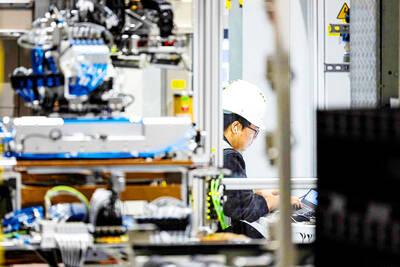Macronix International Co (旺宏電子) yesterday said that stronger-than-expected demand for memory chips from its top client, Nintendo Co, and other new products would fuel growth momentum in the second half of this year, shrugging off the effects of the US-China trade row.
US trade sanctions on Huawei Technologies Co (華為) would barely dent the chipmaker’s shipments to the Chinese company, Macronix said.
The US ban has taken a toll on Huawei, causing its smartphone sales to drop 40 percent over the past month and could cut its revenue by US$30 billion in the next two years, Huawei founder Ren Zhengfei (任正非) told a panel discussion in Shenzhen, China, on Monday.
“Fortunately, we produce very few memory chips for mobile phones,” Macronix chairman Miin Wu (吳敏求) told reporters on the sidelines of the company’s annual general meeting, implying limited impact from the Huawei ban.
While Huawei is one of the Hsinchu-based chipmaker’s top three clients, it accounts for less than 10 percent of its revenue, Wu said.
Macronix primarily supplies NOR flash memory chips used in Huawei’s 5G base stations, he said.
As global trade becomes chaotic due to the trade spat, Macronix is more cautious about the outlook for the second half, Wu said.
“It is certain that the second half would be better than the first half. However, we are not so sure how robust the strength would be,” Wu said, referring to the trade dispute, which has shaken global business confidence and reduced Macronix’s order visibility.
Two months ago, Wu anticipated that the dispute would be over by the end of this month.
However, now, the chances of the world’s two biggest economies resolving the dispute looks slim, he said.
“As uncertainty is high, clients tend to place short-term orders, rather than long-term ones. That makes it difficult for us to make forecasts,” Wu said.
However, orders from long-term client Nintendo “has exceeded our expectations in the past two months,” he said. “Demand is better than we thought.”
Nintendo’s strong demand for ROM memory chips helped boost Macronix’s revenue to NT$2.72 billion (US$86.27 million) last month, up 30 percent from April.
“That is very unusual, as the first and second quarters are usually slow seasons,” Wu said.
To further fuel growth, Macronix plans to mass produce advanced 19-nanometer NAND flash memory chips in the fourth quarter, he said.
The chipmaker has budgeted NT$14.2 billion for new facilities and equipment this year, mostly for 19-nanometer technology.
Shareholders approved a plan to distribute a cash dividend of NT$1.2 per share, representing a 40.49 percent payout ratio based on earnings per share of NT$4.94 last year. That implies a dividend yield of 5.57 percent, based on the stock’s closing price of NT$21.55 yesterday.

CHIP RACE: Three years of overbroad export controls drove foreign competitors to pursue their own AI chips, and ‘cost US taxpayers billions of dollars,’ Nvidia said China has figured out the US strategy for allowing it to buy Nvidia Corp’s H200s and is rejecting the artificial intelligence (AI) chip in favor of domestically developed semiconductors, White House AI adviser David Sacks said, citing news reports. US President Donald Trump on Monday said that he would allow shipments of Nvidia’s H200 chips to China, part of an administration effort backed by Sacks to challenge Chinese tech champions such as Huawei Technologies Co (華為) by bringing US competition to their home market. On Friday, Sacks signaled that he was uncertain about whether that approach would work. “They’re rejecting our chips,” Sacks

It is challenging to build infrastructure in much of Europe. Constrained budgets and polarized politics tend to undermine long-term projects, forcing officials to react to emergencies rather than plan for the future. Not in Austria. Today, the country is to officially open its Koralmbahn tunnel, the 5.9 billion euro (US$6.9 billion) centerpiece of a groundbreaking new railway that will eventually run from Poland’s Baltic coast to the Adriatic Sea, transforming travel within Austria and positioning the Alpine nation at the forefront of logistics in Europe. “It is Austria’s biggest socio-economic experiment in over a century,” said Eric Kirschner, an economist at Graz-based Joanneum

BUBBLE? Only a handful of companies are seeing rapid revenue growth and higher valuations, and it is not enough to call the AI trend a transformation, an analyst said Artificial intelligence (AI) is entering a more challenging phase next year as companies move beyond experimentation and begin demanding clear financial returns from a technology that has delivered big gains to only a small group of early adopters, PricewaterhouseCoopers (PwC) Taiwan said yesterday. Most organizations have been able to justify AI investments through cost recovery or modest efficiency gains, but few have achieved meaningful revenue growth or long-term competitive advantage, the consultancy said in its 2026 AI Business Predictions report. This growing performance gap is forcing executives to reconsider how AI is deployed across their organizations, it said. “Many companies

France is developing domestic production of electric vehicle (EV) batteries with an eye on industrial independence, but Asian experts are proving key in launching operations. In the Verkor factory outside the northern city of Dunkirk, which was inaugurated on Thursday, foreign specialists, notably from South Korea and Malaysia, are training the local staff. Verkor is the third battery gigafactory to open in northern France in a region that has become known as “Battery Valley.” At the Automotive Energy Supply Corp (AESC) factory near the city of Douai, where production has been under way for several months, Chinese engineers and technicians supervise French recruits. “They